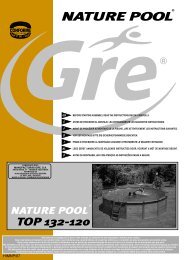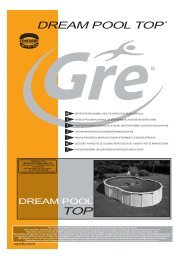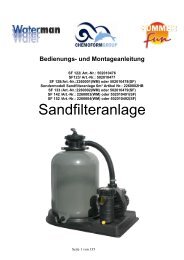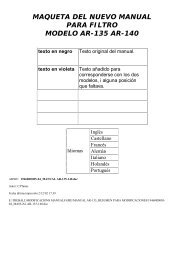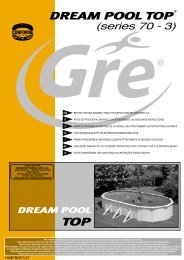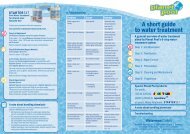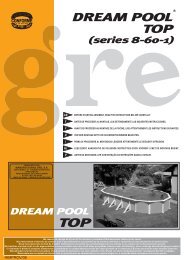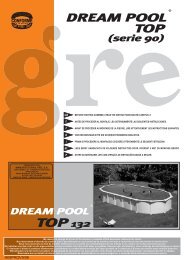manual verificado ar-130 con pasadores y posventa ... - Badepool.de
manual verificado ar-130 con pasadores y posventa ... - Badepool.de
manual verificado ar-130 con pasadores y posventa ... - Badepool.de
Create successful ePaper yourself
Turn your PDF publications into a flip-book with our unique Google optimized e-Paper software.
1.1 REQUIREMENTS FOR CORRECT INSTALLATION<br />
This app<strong>ar</strong>atus is easy to install and can be assembled by one adult in about 2 HOURS, taking c<strong>ar</strong>e to correctly follow the<br />
instructions <strong>de</strong>tailed in this <strong>manual</strong>.<br />
Only the following tools <strong>ar</strong>e required to correctly handle the filter components and to install it.<br />
Task Tool Alternative tool<br />
Tighten the hose flanges 7mm Stecker screwdriver Philips screwdriver<br />
Tighten the screws of pumpe Open-end wrench 13 Open-end wrench 13<br />
Cut the liner Cutter Knife<br />
Protection of collector pipe Piece of plastic Piece of fabric<br />
2 BEFORE CONNECTING THE FILTER<br />
2.1 Location<br />
Place the filter on a flat, solid surface at a minimum distance of 3.5 metres from the pool (in accordance with stand<strong>ar</strong>d NF<br />
C15-100 or the equivalent stand<strong>ar</strong>d of the region or country) and at the same level as the bottom of the pool to prevent air<br />
from entering the cleansing circuit and the filter from becoming unprimed (Fig. 2). The filter should be protected from sun<br />
and rain, and kept it in an <strong>ar</strong>ea with sufficient ventilation during operation. Never cover it during operation.<br />
2.2 Assembly<br />
Before assembling the filter, assemble the skimmer, version AR<strong>130</strong> following the instructions provi<strong>de</strong>d, fig. 3 no. 14,<br />
version AR<strong>130</strong>L fig. 3 no. 13 and AR<strong>130</strong>E fig. 3 no 12, following instructions provi<strong>de</strong>d with the swimming pool.<br />
After the filter has been set into place, proceed as follows:<br />
* Place the lock-pins provi<strong>de</strong>d in the bag of accessories as indicates the fig. 0 to fix the filter to the base.<br />
? Fasten the pump to the base with the screws and washers indicated in the figure (Fig. 7).<br />
? Loosen the screw on the metal band or seal which joins the valve to the filter (Fig.4).<br />
? Remove the TOP selector valve and cover the opening of the inner collector tube with protective plastic in or<strong>de</strong>r to<br />
prevent sand from entering the tube (Fig.5).<br />
? Place the inner collector properly on the bottom of the filter (Fig.6).<br />
? Insert 25 kg. of sand insi<strong>de</strong> the filter. (Fig.5). The silica sand lasts for an unlimited period of time. It should only be<br />
replaced if lost. Record the reference for the level of silica sand for future replacement.<br />
? Eliminate the remains of sand from the filter opening and remove the protective plastic.<br />
? Replace the TOP selector valve with its coupling and secure with the metal band or seal .<br />
? Tighten firmly the screw on the metal band which joins the valve to the filter (Fig.4).<br />
? Connect one end of the 0.40 m. hose (Pos. 5 Fig. 1) to the PUMP terminal of the selector valve by tightening with a<br />
clamp. Connect the other end to the upper p<strong>ar</strong>t of the motor (Fig. 7) with a clamp.<br />
? Connect one end of one of the 4.5 m. hoses (Pos. 7 Fig. 3) to the RETURN terminal of the selector valve using a<br />
clamp (Fig. 7), <strong>con</strong>nect the other end of this hose to the return nozzle in the pool using a clamp (Fig. 3).<br />
? Connect the suction and disch<strong>ar</strong>ge hoses to the suction and disch<strong>ar</strong>ge terminals on the valve, tightening them firmly<br />
with the clamps (Fig.7).<br />
? Insert the Teflon supplied on the thread of the skimmer terminal and <strong>con</strong>nect the other end of the suction hose.<br />
Tighten firmly with a clamp. Repeat the same procedure with the feedback nozzle terminal and <strong>con</strong>nect the disch<strong>ar</strong>ge<br />
hose.<br />
? Following installation, the first cycle of filter backwash should be performed. In or<strong>de</strong>r to do so, follow the instructions in<br />
the section 5.3.<br />
3 ELECTRIC CONNECTION<br />
All electrical installations should comply with the following stand<strong>ar</strong>d:<br />
NF C15-100<br />
NF EN 60-335-2-41<br />
that refers “to the <strong>con</strong>struction of electrical installations, both in indoor and outdoor swimming pools”, or the<br />
equivalent stand<strong>ar</strong>d in force in each region or country.<br />
The pump must be <strong>con</strong>nected to a 220/230 V. alternating current and 50 Hz power point, with e<strong>ar</strong>th <strong>con</strong>nection.<br />
Consumption: 240 W.<br />
An omnipol<strong>ar</strong> switch must be used to ensure there is no power feed to the filter when it is not in use. A 30 mA differential<br />
must also be used to protect from electrical breakdowns. (Not supplied. These items can be purchased at electricity<br />
shops.)<br />
4 TOP SELECTOR VALVE<br />
The top selector valve on the filter is used to select the 4 different filter functions: filtration (FILTER), backwash, waste and<br />
closed. To change the valve setting, proceed as follows:<br />
? Always dis<strong>con</strong>nect the socket.<br />
3



